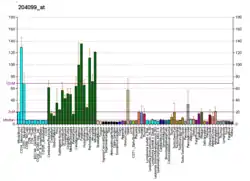SMARCD3
SWI/SNF-related matrix-associated actin-dependent regulator of chromatin subfamily D member 3 is a protein that in humans is encoded by the SMARCD3 gene.[5][6][7]
Function
The protein encoded by this gene is a member of the SWI/SNF family of proteins, whose members display helicase and ATPase activities and which are thought to regulate transcription of certain genes by altering the chromatin structure around those genes. The encoded protein is part of the large ATP-dependent chromatin remodeling complex SNF/SWI and has sequence similarity to the yeast Swp73 protein.
Multiple alternatively spliced transcript variants have been found for this gene.[7] Mutually exclusive incorporation of the variants into the larger SWI/SNF complex are thought to direct the complex to remodel particular sites in chromatin, leading to alterations in gene activity that dictate cell behavior or differentiation during development and disease.[8]
SMARCD3 together with TBX15 triggers development glycolytic fast-twitch muscles by the activation of the Akt/PKB signaling pathway.[9]
References
- GRCh38: Ensembl release 89: ENSG00000082014 - Ensembl, May 2017
- GRCm38: Ensembl release 89: ENSMUSG00000028949 - Ensembl, May 2017
- "Human PubMed Reference:". National Center for Biotechnology Information, U.S. National Library of Medicine.
- "Mouse PubMed Reference:". National Center for Biotechnology Information, U.S. National Library of Medicine.
- Wang W, Xue Y, Zhou S, Kuo A, Cairns BR, Crabtree GR (September 1996). "Diversity and specialization of mammalian SWI/SNF complexes". Genes & Development. 10 (17): 2117–30. doi:10.1101/gad.10.17.2117. PMID 8804307.
- Ring HZ, Vameghi-Meyers V, Wang W, Crabtree GR, Francke U (July 1998). "Five SWI/SNF-related, matrix-associated, actin-dependent regulator of chromatin (SMARC) genes are dispersed in the human genome". Genomics. 51 (1): 140–3. doi:10.1006/geno.1998.5343. PMID 9693044.
- "Entrez Gene: SMARCD3 SWI/SNF related, matrix associated, actin dependent regulator of chromatin, subfamily d, member 3".
- Puri PL, Mercola M (December 2012). "BAF60 A, B, and Cs of muscle determination and renewal". Genes & Development. 26 (24): 2673–83. doi:10.1101/gad.207415.112. PMC 3533072. PMID 23222103.
- "Enhanced exercise and regenerative capacity in a mouse model that violates size constraints of oxidative muscle fibres | eLife".
Further reading
- Wang W, Côté J, Xue Y, Zhou S, Khavari PA, Biggar SR, Muchardt C, Kalpana GV, Goff SP, Yaniv M, Workman JL, Crabtree GR (October 1996). "Purification and biochemical heterogeneity of the mammalian SWI-SNF complex". The EMBO Journal. 15 (19): 5370–82. doi:10.1002/j.1460-2075.1996.tb00921.x. PMC 452280. PMID 8895581.
- Shanahan F, Seghezzi W, Parry D, Mahony D, Lees E (February 1999). "Cyclin E associates with BAF155 and BRG1, components of the mammalian SWI-SNF complex, and alters the ability of BRG1 to induce growth arrest". Molecular and Cellular Biology. 19 (2): 1460–9. doi:10.1128/mcb.19.2.1460. PMC 116074. PMID 9891079.
- Barker N, Hurlstone A, Musisi H, Miles A, Bienz M, Clevers H (September 2001). "The chromatin remodelling factor Brg-1 interacts with beta-catenin to promote target gene activation". The EMBO Journal. 20 (17): 4935–43. doi:10.1093/emboj/20.17.4935. PMC 125268. PMID 11532957.
- Otsuki T, Furukawa Y, Ikeda K, Endo H, Yamashita T, Shinohara A, Iwamatsu A, Ozawa K, Liu JM (November 2001). "Fanconi anemia protein, FANCA, associates with BRG1, a component of the human SWI/SNF complex". Human Molecular Genetics. 10 (23): 2651–60. doi:10.1093/hmg/10.23.2651. PMID 11726552.
- Nagaraja GM, Kandpal RP (January 2004). "Chromosome 13q12 encoded Rho GTPase activating protein suppresses growth of breast carcinoma cells, and yeast two-hybrid screen shows its interaction with several proteins". Biochemical and Biophysical Research Communications. 313 (3): 654–65. doi:10.1016/j.bbrc.2003.12.001. PMID 14697242.
- Debril MB, Gelman L, Fayard E, Annicotte JS, Rocchi S, Auwerx J (April 2004). "Transcription factors and nuclear receptors interact with the SWI/SNF complex through the BAF60c subunit". The Journal of Biological Chemistry. 279 (16): 16677–86. doi:10.1074/jbc.M312288200. PMID 14701856.
- Mahmoudi T, Parra M, Vries RG, Kauder SE, Verrijzer CP, Ott M, Verdin E (July 2006). "The SWI/SNF chromatin-remodeling complex is a cofactor for Tat transactivation of the HIV promoter". The Journal of Biological Chemistry. 281 (29): 19960–8. doi:10.1074/jbc.M603336200. PMID 16687403.
- Olsen JV, Blagoev B, Gnad F, Macek B, Kumar C, Mortensen P, Mann M (November 2006). "Global, in vivo, and site-specific phosphorylation dynamics in signaling networks". Cell. 127 (3): 635–48. doi:10.1016/j.cell.2006.09.026. PMID 17081983. S2CID 7827573.




